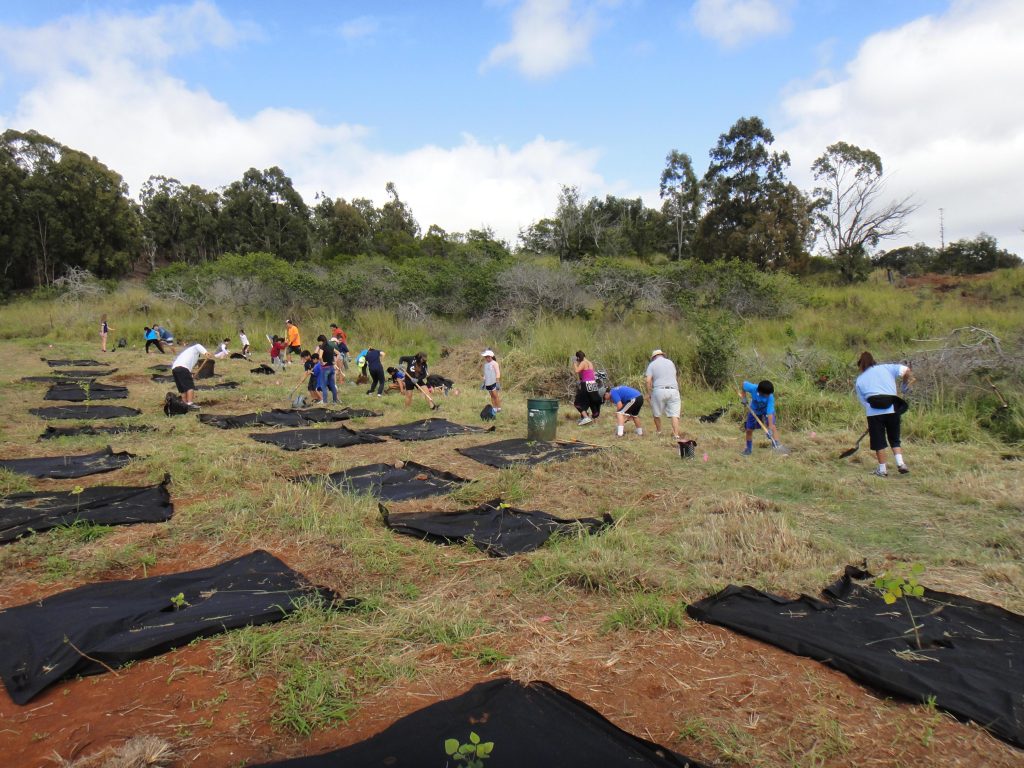UH Mānoa Aims to Fully Offset Carbon Emissions
The Carbon Neutrality Challenge, a joint project of the University of Hawaiʻi at Mānoa and numerous organizations, aims to test the feasibility of restoring local ecosystems to offset all of the state’s carbon emissions.
The group held its first proof-of-concept event on Nov. 17, 2018, at Ala Mahamoe Cultural Garden and Forest near Tripler Hospital. At the event, six teams of volunteers from UH Mānoa and various student groups, local organizations and businesses joined together in friendly competition to plant a record-setting 1,000 trees in one day. At the end of the day’s competition, teams were ranked according to the number of trees planted, with rankings available online.
The goal of the event was to demonstrate the state’s ability to scale up restoration, and plant trees by the number needed to position Hawaiʻi as the first place in the world to fully offset its carbon emissions via ecosystem restoration.
“The solution to climate change is staring at us. It is as simple as planting sufficient trees to offset one’s emissions,” said Camilo Mora, associate professor of geography in UH Mānoa’s College of Social Sciences and lead investigator in the project.
“The math is simple,” said Asryelle Mora Rollo, a 6th grader and one of the project’s members. “The average carbon footprint of a person in Hawaiʻi is estimated at ~12 tonnes of CO2 each year. It will take 12 Milo trees just below five years to remove all of that carbon. Or you can try three Koas, or ~20 Ohias, or a diversity of other native trees that can do the job for you. We just need to go and put those trees in the ground.”
While it may look daunting to restore all Hawaiian ecosystems in order to store the amount of carbon necessary to make the state carbon neutral, the group believes Hawaiʻi has the resources and manpower to do this—it just needs to put these parts together.
The group notes that, with a million people in the state, if each person plants just one tree, Hawaiʻi can easily have a million trees in the ground within a week. Scalability is certainly possible and, if successful, would create an environmental balance between nature and humans. The group hopes that the one-day planting event will inspire others to take on the challenge of restoring Hawaiʻi’s ecosystems by hosting similar competitions.
“Land to plant trees is certainly not a bottle neck at the moment,” said Myles Ritchie of The Outdoor Circle and one of the coordinators of the project. “Over 80% of the natural land cover in the state has been transformed or severely degraded, and both state and land owners are eager to change that.”
“With the amount of degraded areas choked by invasive species, there will be no shortage of land,” said JC Watson, manager of the Koʻolau Mountains Watershed Partnership and project coordinator of the site where the planting event took place. “The benefits of restoring our native forests will be many, not only for watershed health, but also capturing and storing carbon.”
“Currently, we do not have the infrastructure for seedling propagation to scale up planting, but that is nothing that cannot be fixed,” said Ryan Peralta from the Hawaiʻi Department of Land and Natural Resources. “Certainly, we have hundreds of native species that are calling out loud for our help.”
“This project offers a unique opportunity for all of us, including companies, to fulfill our environmental responsibilities,” added Zak Barry from Banan Hawai‘i, one of the local companies involved in the project. “Given the environmental nature of people in our state, I see many more people getting on this.”
The tree-planting pilot event is part of UH Mānoa’s Carbon Neutrality Challenge, an initiative that aims to provide a mechanism for people to pay their ecological debt to Earth. It is based on the premise that climate change can be solved if individuals calculate how much CO2 they generate, estimate the number of trees needed to sequester those emissions and plant the required number of trees.
Despite increasingly obvious consequences of deadly heatwaves, hurricanes, floods, droughts, wildfires, and other climatic changes, greenhouse gas emissions remain largely unabated. While considerable attention has been given to improvements in energy efficiency and renewable energy sources as a way to reduce emissions, much less serious attention has been given to improving the state of natural ecosystems as sinks of such emissions. For instance, if restored, global natural forest may stock >460 billion tonnes of carbon, or all human carbon emissions at current rates for 50 years. That degree of ecosystem restoration, however, poses numerous big challenges.














